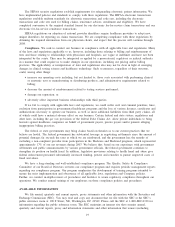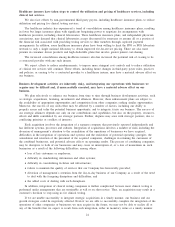Quest Diagnostics 2007 Annual Report Download - page 31
Download and view the complete annual report
Please find page 31 of the 2007 Quest Diagnostics annual report below. You can navigate through the pages in the report by either clicking on the pages listed below, or by using the keyword search tool below to find specific information within the annual report.Healthcare insurers have taken steps to control the utilization and pricing of healthcare services, including
clinical test services.
We also face efforts by non-governmental third party payers, including healthcare insurance plans, to reduce
utilization and pricing for clinical testing services.
The healthcare industry has experienced a trend of consolidation among healthcare insurance plans, resulting
in fewer but larger insurance plans with significant bargaining power to negotiate fee arrangements with
healthcare providers, including clinical laboratories. These healthcare insurance plans, and independent physician
associations, may demand that clinical laboratories accept discounted fee structures or assume all or a portion of
the financial risk associated with providing testing services to their members through capitated payment
arrangements. In addition, some healthcare insurance plans have been willing to limit the PPO or POS laboratory
network to only a single national laboratory to obtain improved fee-for-service pricing. There are also more
patients in consumer driven products and high deductible plans that involve greater patient cost-sharing.
The increased consolidation among healthcare insurers also has increased the potential risk of ceasing to be
a contracted provider with any such insurer.
We expect efforts to reduce reimbursements, to impose more stringent cost controls and to reduce utilization
of clinical test services will continue. These efforts, including future changes in third-party payer rules, practices
and policies, or ceasing to be a contracted provider to a healthcare insurer, may have a material adverse effect on
our business.
Business development activities are inherently risky, and integrating our operations with businesses we
acquire may be difficult and, if unsuccessfully executed, may have a material adverse effect on our
business.
We plan selectively to enhance our business from time to time through business development activities, such
as strategic acquisitions, licensing, investments and alliances. However, these enhancement plans are subject to
the availability of appropriate opportunities and competition from other companies seeking similar opportunities.
Moreover, the success of any such effort may be affected by a number of factors, including our ability to
properly assess and value the potential business opportunity, and to integrate it into our business. The success of
our strategic alliances depends not only on our contributions and capabilities, but also on the property, resources,
efforts and skills contributed by our strategic partners. Further, disputes may arise with strategic partners, due to
conflicting priorities or conflicts of interests.
Each acquisition involves the integration of a separate company that previously operated independently and
has different systems, processes and cultures. Integration of acquisitions involves a number of risks including the
diversion of management’s attention to the assimilation of the operations of businesses we have acquired,
difficulties in the integration of operations and systems and the realization of potential operating synergies, the
assimilation and retention of the personnel of the acquired companies, challenges in retaining the customers of
the combined businesses, and potential adverse effects on operating results. The process of combining companies
may be disruptive to both of our businesses and may cause an interruption of, or a loss of momentum in, such
businesses as a result of the following difficulties, among others:
•loss of key customers or employees;
•difficulty in standardizing information and other systems;
•difficulty in consolidating facilities and infrastructure;
•failure to maintain the quality of services that our Company has historically provided;
•diversion of management’s attention from the day-to-day business of our Company as a result of the need
to deal with the foregoing disruptions and difficulties; and
•the added costs of dealing with such disruptions.
In addition, integration of clinical testing companies is further complicated because most clinical testing is
performed under arrangements that are terminable at will or on short notice. Thus, an acquisition may result in a
customer’s decision to stop using us for clinical testing.
If we are unable successfully to integrate strategic acquisitions in a timely manner, our business and our
growth strategies could be negatively affected. Even if we are able to successfully complete the integration of the
operations of other companies or businesses we may acquire in the future, we may not be able to realize all or
any of the benefits that we expect to result from such integration, either in monetary terms or a timely manner.
22
























